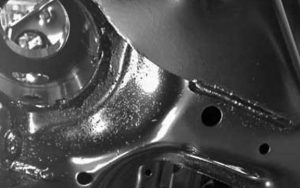Another consideration in welding through stamping lubricants is how weld spatter can be impacted.

Once again, the preponderance of evidence suggests welding clean surfaces is the best practice, but many manufacturing facilities opt to weld through stamping lubricant and mill oil films on metal surface regardless. Oddly enough, even though residues are created along the weld beads and surrounding areas, the “surface soils” can sometimes provide a level of spatter protection.
The balance tips in the favor of oil-free, synthetic stamping fluids over oil-based and/or emulsifiable-oil fluids. This is due to the cleaner and lower temperature burn-off tendencies of the oil-free products and their comparatively drier residues. The residues left behind by oil-free stamping fluids can provide just enough surface protection to prevent spatter adhesion to the part surface—or at least lessen the bond strength for easier removal. Oil-based and emulsifiable oil stamping fluids tend to generate a heavier, “varnish-like” residue that is very tacky and hard to remove. Oil-based products may actually increase spatter in some instances, and even worse, lead to other issues like porosity.
There are many aspects that can contribute to spatter generation: amperage and voltage settings being improper, erratic wire feed, distance from weld tip to work surface, etc. but films left behind from mill oils and stamping fluids can contribute and are avoidable.
IRMCO always recommends the welding of clean metal surfaces to avoid any unpleasant or unexpected results.

Coming soon: Weld Porosity

